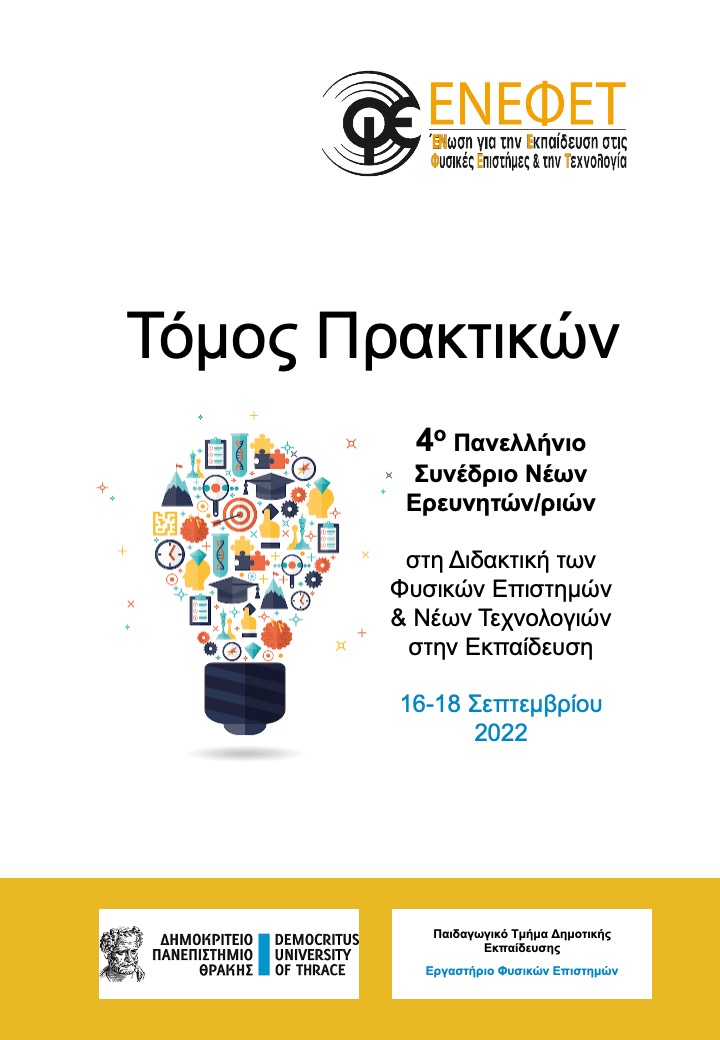Διερεύνηση Διδακτικών Παρεμβάσεων σε Μαθητές Λυκείου, σε θέματα σύγχρονης φυσικής, με αξιοποίηση πολλαπλών αναπαραστάσεων

Published:
Sep 14, 2024
Keywords:
elementary particle physics masterclass didactic transposition/transformation
Abstract
It is an indisputable fact that the subjects of modern physics that are included so far in the curricula of secondary education are few. In papers that refer to relevant topics, it was found that the introduction of modern physics in education, is a key research question in the teaching of physics. The present work focuses on elementary particle physics and its integration into education. The research questions of the work include the achievement of cognitive and scientific goals, through a suitably designed Teaching Learning Sequence, utilizing multiple representations. In the first stage of the work, we investigate the level of students' knowledge about particle physics and whether it can be a source of interest in physics in general.
Article Details
- Section
- PhDs
References
Barlow, R. (1992). Particle physics: from school to university. Phys. Educ. 27(2), 92–5. https://iopscience.iop.org/article/10.1088/0031-9120/27/2/007
Bertozzi, E., Levrini, O., & Rodriguez, M., (2013). Symmetry as Core-idea for Introducing Secondary School Students to Contemporary Particle Physics. Procedia - Social and Behavioral Sciences, 116, pp 679-685. https://doi.org/10.1016/j.sbspro.2014.01.279
Duit, R. (2007). Science education research internationally: Conceptions, research methods, domains of research. Eurasia Journal of Mathematics, Science and Technology Education, 3(1), pp 3-15.
Duit R., Gropengießer H., Kattmann U., Komorek M. & Parchmann I. (2012) The Model of Educational Reconstruction Framework for Improving Teaching and Learning Science 1. In Science education research and practice in Europe. Sense Publishers, pp. 13-37.
Gourlay, H., (2017). Using concept mapping to learn about A level physics students’ understandings of particle physics. Proceedings, 6th International Conference on New Frontiers in Physics (ICNFP 2017), EPJ Web of Conferences 182. https://doi.org/10.1051/epjconf/201818202050
Johansson K., Kobel M., Hillebrandt D., & Euler M. (2007). European particle physics masterclasses make students into scientists for a day. Physics Education, 42(6), p.636.
Lewerissa, K., Pol, H., Brinkman, A. & Wouter van Joolingen. (2017). Insights into teaching quantum mechanics in secondary and lower undergraduate education. Phys. Rev. ST Phys. Educ. Res. 13, 010109. https://doi.org/10.1103/PhysRevPhysEducRes.13.010109
Michelini, M., Santi, L. & Stefanel, A. (2015) Teaching modern physics in secondary schools. Proceedings, 14th International Symposium Frontiers of Fundamental Physics (FFP14).
Psillos, D., & Kariotoglou, P. (2016). Theoretical Issues related to Designing and Developing Teaching – Learning Sequences. In D. Psillos, P. Kariotoglou (Eds), Iterative Design of Teaching - Learning Sequences, pp 11-34. Springer. ISBN 978-94-007-7807-8.
Polen, C. (2019). Particle Physics: An Essential and Engaging Part of the High School Physics Program. The Physics Teacher, 57(5), pp 320. https://doi.org/10.1119/1.5098922
Stadermann, H., van den Berg, E. & Goedhart, M. (2019). Analysis of secondary school quantum physics curricula of 15 different countries: Different perspective on a challenging topic. Phys. Rev. Phys. Educ. Res. 15, 010130. https://doi.org/10.1103/PhysRevPhysEducRes.15.010130
Tuzón P. & Solbes J. (2016). Particle Physics in High School: A Diagnose Study. PLoS ONE 11(6): e0156526. https://doi.org/10.1371/journal.pone.0156526





